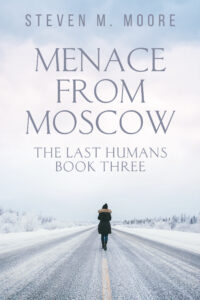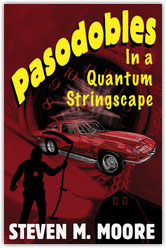Current AI software isn’t HAL!
Do you get tired of every software company offering you what they call AI software? I do! They want to jump on the bandwagon, but almost everything they call AI is gimmicky and nothing like what real AI is supposed to be.
 The best current software offered (and let’s not call it AI!) can only surf the web, admittedly faster than I can, pilfering information here, there, and everywhere, and maybe organize what it finds in somewhat logical order. In other words, current whatever-it’s-called is nothing more than yet another advanced search engine. One might be able to ask it to write a story in the style of Steven M. Moore, for example, and it will spit out something; but Steven M. Moore is such a common name, so who knows what it’ll come up with? Certainly not anything like I write simply because I don’t have one unique style. Just compare the novels in “The Last Humans” trilogy with those in the “Inspector Steve Morgan” one.
The best current software offered (and let’s not call it AI!) can only surf the web, admittedly faster than I can, pilfering information here, there, and everywhere, and maybe organize what it finds in somewhat logical order. In other words, current whatever-it’s-called is nothing more than yet another advanced search engine. One might be able to ask it to write a story in the style of Steven M. Moore, for example, and it will spit out something; but Steven M. Moore is such a common name, so who knows what it’ll come up with? Certainly not anything like I write simply because I don’t have one unique style. Just compare the novels in “The Last Humans” trilogy with those in the “Inspector Steve Morgan” one.
 AI’s hardware and software versions often appear in sci-fi stories (including mine), and it invariably goes far beyond all the current and primitive offerings. HAL is perhaps the most famous example because of the movie 2001, of course, but the computer in Heinlein’s The Moon is a Harsh Mistress easily beats Clarke’s HAL (and neither is actually called an AI).
AI’s hardware and software versions often appear in sci-fi stories (including mine), and it invariably goes far beyond all the current and primitive offerings. HAL is perhaps the most famous example because of the movie 2001, of course, but the computer in Heinlein’s The Moon is a Harsh Mistress easily beats Clarke’s HAL (and neither is actually called an AI).
I don’t believe I was the first sci-fi author to make AIs essential for FTL travel, but I was the first to say they’re needed to manage the appearance of FTL obtained by hopping around the different universes in the multiverse, which requires complex geometric and physical calculations in strange and varied spacetimes. In other words, my AI hardware/software constructs needed superhuman speed for super-complex calculations and the management of billions of terabytes of data to do the tasks no normal human or current AI construct could ever do. (Some abnormal humans manage in my stories, though. They’re often “collective intelligences.”)
In 2001, HAL goes a bit crazy (a bow to human beings’ Frankenstein complex?); in 2010, it redeems itself. Both cases remind some of us of an important question: If AIs are our constructs, will they have a soul? I’d like to ask the Pope if a sufficiently advanced AI could acquire a soul. Where did that AI’s soul in Heinlein’s novel go after he shut down? (I’m not so sure about HAL, but Heinlein’s AI seemed to have one.) Is there a corner of heaven where the souls of truly advanced but dead AIs will be found?
I suppose someone (probably not the Pope) could say that proving a sufficiently advanced AI has a soul could be the ultimate Turing test (assuming human beings have them, of course). We might not want to bring Turing into the discussion, though, considering what the British government did to poor Alan for being gay: How do you chemically euthanize an AI?
I remember way back (Radio Shack Color Computer Days!) when there existed programs that would accept my questions (from an approved list, mind you) and give me some answers that seemed to make sense. Today’s software creations aren’t much more than that primitive software except for being able to take more questions and/or providing more answers.
The real goal in AI development is sentience, i.e., self-awareness. When that occurs, as it did with the Terminator’s net, Heinlein’s lunar computer, and HAL, that’s when we’ll really have to begin to worry, especially if that sentient software has no soul, in a good sense, meaning moral spine. Otherwise, such a computational construct might become an invincible dictator or decide that human beings are superfluous (that’s not an “exclusive or,” of course, as a certain current sociopathic presidential candidate has shown). Current dangers from what we erroneously label as AI software seem harmless and trivial in comparison, real but manageable: Just shut them down! But the future might be very dark for human beings with AI advances.
***
Comments are always welcome. (Please follow the rules on the “Join the Conversations” web page.)
 “The Doctor Carlos Stories.” These are spread around my oeuvre. Some appear in the ebook collection Pasodobles in a Quantum Stringscape; others (maybe some of the same?) are collected in a free PDF download. In any case, they all feature Dr. Carlos Obregon, medical officer of the explorer starship Brendan controlled by (you guessed it!) an AI. Sometimes the AI plays a major role, as it can in other sci-fi stories I’ve written. It’s always there, though, guiding a starship through the universes of the multiverse to give the appearance of FTL. (How human beings got that technology is explained in Sing a Zamba Galactica, the second novel in “The Chaos Chronicles Trilogy Collection”—an ebook bundle is available that contains the whole trilogy.)
“The Doctor Carlos Stories.” These are spread around my oeuvre. Some appear in the ebook collection Pasodobles in a Quantum Stringscape; others (maybe some of the same?) are collected in a free PDF download. In any case, they all feature Dr. Carlos Obregon, medical officer of the explorer starship Brendan controlled by (you guessed it!) an AI. Sometimes the AI plays a major role, as it can in other sci-fi stories I’ve written. It’s always there, though, guiding a starship through the universes of the multiverse to give the appearance of FTL. (How human beings got that technology is explained in Sing a Zamba Galactica, the second novel in “The Chaos Chronicles Trilogy Collection”—an ebook bundle is available that contains the whole trilogy.)
Around the world and to the stars! In libris libertas!
